Hyundai Staria review and buyer’s guide
Shopping for a big seven-seat SUV or eight-seat people mover? Kia Carnival might be king of triplet transport, but the Hyundai Staria is built for massive families and small business…
The Hyundai Staria is a people mover heavily focussed on being the most practical big-family transporter it can be.
If you think you need a fashionable or stylish family SUV, the Staria would suggest it’s you who needs to change.
The mighty Kia Carnival has for years been the most popular among people mover buyers, and Hyundai Staria is the latest people mover to the category, but arguably, it could be the better option depending on what you need.
The Kia Carnival gets advantageous luxury and multi-talented functionality, but the Staria takes a big-hammer approach, by offering maximum possible cargo and/or passenger space. It’s pretty big - even when you compare it with the large 7-seat SUVs like Kia Sorento, Hyundai Palisade or Hyundai Santa Fe, or the Mazda CX-9.
Exactly how does Staria beat most other vehicles for cabin and luggage capacity? Just take a look at its fundamentals like wheelbase, length, and height.
It’s just over 5.2 metres in length, it’s virtually 2 metres wide and, quite notably, it’s 2 metres tall - about 215mm taller than Carnival. But it’s pretty much the same length and width.
However, when it comes to wheelbase, Carnival is 3.09 metres long versus Staria’s 3.27 metres, an advantage of over 18 cm to the Hyundai. This means it’s more bus-like than the Carnival, which is very clever at tricking you into thinking it’s a big SUV. Staria is unashamedly the vehicle to buy if you have four kids, three of whom are going to be future NBA stars.
To sum up Staria, it’s basically a people mover van, but with the Santa Fe’s level of equipment and not quite its upper-level of plush comfort, but only because it’s based on the Staria Load van: Full in-depth review here >>.
If you have more than two kids in child restraints, you’ll need to look at the Carnival, because Staria only gets two ISOFIX anchorage positions on the row-2 outboard seats, with matching top tether points and a third in the centre row 2 seat. But ISOFIX is the only way to go with child restraints, so it’s almost pointless unless you have a once-off seat fitment.
But in that case, you don’t get to choose when you have a crash (broadly speaking), however unlikely it may seem that something would happen on the way home from whatever.
FEATURES & PRICING
You get three versions of Staria, the base model ‘Staria’ (because Hyundai Australia is continuing that bizarre double-naming convention they started with Santa Fe). The entry-level Staria is about $54K driveaway for the V6 petrol, and goes up to $57K for the 2.2 diesel all-wheel drive.
The mid-range Staria Elite wants $62K driveaway for V6 petrol and it’s $65,400 for the AWD diesel.
Top-spec Highlander can be had for $69,500 driveaway for the petrol and $72,600 for the AWD diesel.
Depending on your usage case, I would recommend the Elite due to the inclusion of all the automated features like doors and tailgate, most of the software tech and the good seats with heating/cooling - while saving you a few grand going up to Highlander for only the dual glass panoramic sunroof, the big internal rear seating monitor system with intercom and - what, the PlayStation parking feature on a slightly bigger LCD screen? Oh and internal LED lights with twin glove box.
Thing is, if you have a small chauffer business, perhaps taxiing wealthy people around in some kind of quasi party bus, or touring small groups of well-off tourists around, then absolutely, get the Highlander Staria at $72K for the smooth, go-almost-anywhere AWD diesel. Make your guests feel like they’re bit special.
But for mums and dads with kids doing exams and telling you how coding works in between Queen’s birthday long weekend glamping expeditions and snowboarding adventures, then you’ll just as full use out of a mid-spec Elite Staria as you would the Highlander. Same goes if you’re thinking of hitting the streets for Uber or as a maxi-taxi - I think Staria will be a better tchoice than Carnival and in a lower spec.
If your kids are still in that disobedient, early teenage period where treating your stuff with respect is a few family arguments away, or even if you still need the maximum loadspace potential of a Staria but you perhaps can’t stretch the family’s budget to low or mid-$60K, then sticking a Peasant’s Staria in your driveway is going to be a very conservative, producent investment. There’s nothing to be sneezed at spending mid-$50K on a people mover which is absolutely fit-for-purpose.
Staria will be a noble ally to your tribe no matter which spec you land on. It will carry your maxi-taxi enterprise with pride, regardless of whether you have an ABN or not.
And Hyundai has proven for many years it will not snub you when presenting them with a legitimate problem, unlike the Volkswagens of the world. And we know Hyundai and Kia will certainly be here, commercially, for the foreseeable future, unlike over the fence at Honda.
And good luck waiting geologic time for an overpriced, 2.8-diesel shitbox powered, rear-drive-only Toyota Granvia to arrive in your driveway in, probably, 12 months’ time.
TECH & TOYS
The touchscreen in base model Staria is an 8-inch job, or in Elite and Highlander it’s a 10.25-incher as in Santa Fe. There’s wireless Apple CarPlay & Android Auto on the base model only - but it’s cable-only on the Elite and Highlander which is a weird consequence of the relationship Apple and Google have with carmakers.
You can connect two devices via Bluetooth, Hyundai’s standard issue sat-nav is on Elite and Highlander with live traffic updates, a 6-speaker audio system across the range, DAB+ on Elite and Highlander, and ‘Quiet Mode’ (speaker volume limitation) for a quieter cabin on all models. Wireless phone charging is there on Highlander only, as I understand.
Staria gets the push-button transmission selector as seen on Santa Fe, Tucson and Palisade. It’s not bad, but can be difficult to manipulate eyes-free when you’re trying to perform a quick low-speed change-of-direction such as reversing into a driveway or doing a three-point-turn.
The main issue is you’re trying to pinpoint the correct button based on haptic feedback - but all three buttons (R, N and D) feel the same - and you’re trying to focus your attention on the steering and other traffic, so it can divert your focus having to find ‘D’ while turning the wheel, checking your mirrors and getting your indicator on.
However, when you get this cognitive ballet right and you learn to hit those bullseyes, it can be a fairly slick operation. Just takes practice.
Hyundai has, unfortunately, gone a bit overboard with the tech when it comes to communicating basic information to the driver. The tacho is now some random curved fan-like shape of coloured lines which illuminate as the revs increase. It’s a dreadful way to communicate how fast the engine is spinning because it’s vague and looks like cheap Playstation graphics. Not to mention it’s mirrored on the other side for the speedo, which you also struggle to distinguish from fanciful graphic design.
Thankfully, they did manage to still use actual numbers to convey the correct information.
SAFETY
Staria has a driver attention warning to help you avoid getting distracted, forward collision-avoidance uses camera and radar and includes car/pedestrian/cyclist detection while operating in city/urban and interurban operational speeds, and the blindspot system will kick in to stop you reversing over little ones in the driveway - although it was not tested by ANCAP in 2021.
There’s a new ‘Junction Turning’ version of collision avoidance, which gives you a haptic vibration warning through the steering wheel if you attempt to turn across the path of an oncoming vehicle - which is great for those dodgy intersections where oncoming cars can appear like bullets from behind another anxious turning vehicle at the same set of lights.
High beam assistance slaps those high beams down if you’ve left them on in the face of an oncoming vehicle.
So-called ‘Lane Following Assist’ and ‘Lane Keeping Assist’ help you do that menial task of actually paying attention to the fricken road and, like bowling alley bumpers, tries to keep you between the white lines if you have a momentary lapse of competence. ‘Leading Vehicle Departure Alert’ is constantly checking out the arse of the preceding vehicle in the event they start to suffer that same momentary lapse of cognitive and physical ability to drive.
There’s ‘rear occupant alert’, four parking sensors and four reverse sensors with guidance display, a front-view and rear-view camera with dynamic guide lines, intelligent speed limiter, emergency stop signal, and a very important tyre pressure monitoring system.
Staria gets a five-star ANCAP safety rating (as does the four-star Hyundai Palisade >> which was upgraded to five stars in 2022.)
The Insurance Institute for Highway Safety (IIHS) has not tested the Staria because it’s not for sale in the LHD North American market, but EuroNCAP did crash test Hyundai Staria as a remarkably safe vehicle both in physical tests and in avoiding one altogether. Here’s how the testing looked:
AIRBAGS - all standard: Front airbags include driver & front passenger, of course; there’s side (thorax) airbags for driver & front passenger, and the industry-new front centre airbag, plus side curtain airbags included on all three rows.
360-DEGREE CAMERA SYSTEM - STANDARD.
A 360-degree camera system is standard on the Staria range, but it can include a (seemingly PlayStation 2 quality) 3D graphic display of the vehicle on the Elite and Highlander. It uses cameras from the front-view, and rear-view cameras and fill-in information from the front/rear cross-traffic sensors. It’s kinda clever, I guess, but a bit gimmicky. They’re all like this.
Safe Exit Assist (Elite & Highlander)
If one of your half-asleep teenage kids attempts to open the side door and step out into incoming traffic, the Staria will detect this approaching vehicle and disable the door latch mechanism so it won’t open until the threat vehicle has passed.
Rear Cross-Traffic Collision Avoidance-Assist (Standard)
Another radar system that slams on the brakes if you’re reversing down a driveway (where the vast majority of reversing fatalities happen), or coming out of a carpark and some random errant kid or dog steps out into the path of your oncoming breeder bus.
Very useful in a vehicle with potentially intimidating proportions closer to a commercial short-wheelbase bus than a regular SUV. Combined with mirrors adjusted correctly (turned outward to NOT see the side of the vehicle down the inside of the mirror), you should be able to keep track of all traffic in both directions. RCTA will beep at you pretty intensely in busy traffic, so try to desensitise yourself from it by not being panicked and interpret the beeping as information, rather than a scary warning.
Remember, these features are prevalent on all new vehicles now, and they’re designed to at least try to help you. So don’t hate them or fight them, try to work with them. A feature like this only needs to work once, in combination with ‘Rear Blind-Spot Collision-Avoidance Assist’ (standard across the range), to pay for itself.
If you watch the video of Staria’s crash testing, you might spot that in the ‘Far Side Impact’ test, which simulates what happens to occupants (and how well the vehicle protects them from) opposite side impacts to the vehicle, the dummy actually misses the front-centre airbag. This means the forces imposed on the dummy occupant, that would’ve been managed and mitigated by the front-centre airbag, are negated - or so you might think. Interestingly, this was not enough to trigger any points deductions.
Where Staria was marked down was for rear occupant protection in the 50km/h full width crash test, where a ‘marginal’ and ‘poor’ score were given (and points deducted), respectively, for the chest and the submarining of the upper legs.
Just for context here, that doesn’t automatically render Staria a safety deathtrap. It’s less than ideal, yes, and rightly so was marked down. In the same way the oblique pole test at 32km/h is a very severe crash and resulted in a ‘weak’ rating for chest protection in that scenario, points are deducted.
But that doesn’t strictly render it a fatal result. It’s still survivable, just with higher loads placed on the occupant and more work for paramedics.
Hyundai Staria gets a five-star ANCAP safety rating: Download the technical report here >>
It’s also worth noting that if you’ve managed to hit a tree at 32km/h directly into the driver’s door, you’ve probably made a critical error in your driving, because even the side impact from the 60km/h trolley (pictured above) didn’t have that kind of result on the dummy.
What’s also to note here is that there isn’t actually much Hyundai’s engineers can do to improve on that oblique pole test due to the height, shape and design of the Staria in that location where the pole hits. The curtain airbag deploys perfectly, the front airbag does the same, and the seatbelt’s pyrotechnic pre-tensioning wizardry is in damn-near perfect choreography.
If you’re hitting a power pole at 32km/h sideways, something has gone very wrong
Staria might have a notionally ‘big’ door, but it’s very tall and has comparatively less metal to absorb the impact at its highest load point - in the centre. There’s less door pushing back at the point of impact, particularly if you look at a large SUV like Palisade or Santa Fe which better distribute that inertia into the chassis, the roof and the safety cell built into the cockpit compartment.
Whereas the Staria is built on the Satria-Load’s van platform, which is essentially a box with minimal structural reinforcement in areas like doors. It’s basically the floor and the roof, and the door’s thin sheetmetal pushing back against the pole.
The fact that Staria does as well as it does is actually a huge credit to Hyundai for making a commercial vehicle remarkably safe in spite of the time-honoured tradition of carmakers building any light commercial as a complete safety shitbox with bare minimal (or less) in terms of safety design considerations.
And just for one last dop of context here, that oblique pole test is brutal.
Also worth mentioning is that Staria’s crash avoidance systems are very good. They mitigated all the potentially fatal impacts with vulnerable road users like wayward kamikaze cyclists and errant pedestrians staring at the phone while crossing a busy main road.
The ability for a 2-tonne people mover, that’s longer and taller than a LandCruiser, to wipe of speed in such a short distance is remarkable. There are smaller medium SUVs which fail these tests in which the hypothetical vulnerable road user would be very lucky to survive in the real world.
Good work Hyundai for the auto emergency braking systems in the Staria managing to pull this beast up, especially in the ‘obstructed’ tests here.
There’s a Whole Lotta Staria down the back, so standard 360-degree camera + RCCA is helpful; ‘AEB Backover’ missing.
Good news. Staria gets a full-size 18-inch alloy spare wheel and tyre. So your party of eight won’t have to limp home at 80km/h in the dark on the freeway mixing with school holiday traffic.
The jack and tyre brace are stowed in a convenient little cubby under the driver’s seat, but you’ll have to watch for traffic if you’re forced to pull over onto the shoulder because you’ll be doing it on the closest side to the road.
ENGINE
Two straightforward options when it comes to powertrain in the Staria. You get an outdated dinosaur-come-museum piece that is the 3.5-litre petrol V6 sending all its high-revving power directly to the front wheels. If you want to know why this boat-anchor V6 sucks, check out: Why Most V6 Engines are so Terrible >>
Or there’s the standout engine in Hyundai and Kia’s inventory - the 2.2L turbo-diesel four-cylinder. Like in the Santa Fe and Palisade, is connected to Hyundai’s HTRAC all-wheel drive system. This is such a unique and highly practical powertrain, and it’s one salient advantage of buying a Staria over the venerable Kia Carnival, which only comes in front-wheel drive form, regardless of the same petrol V6 or 2.2 turbo-diesel.
To give you the simple version of why the diesel kills the V6, let’s start with power. The diesel offers 130kW at just 3800 RPM when the V6 can make 200kW - you have to rev it to 6400 RPM in order to access all that power. The diesel is so much more efficient at giving you power in the optimum driving revs, which is down low at 2000-3000 RPM.
Staria transmission is an eight-speed epicyclic automatic on all grades. If you don’t know what that means, here’s my Ultimate Transmission Guide >> to learn you.
Now, admittedly, in Highlander form (most amount of toys means at its heaviest), the V6 version offers a power-to-weight ratio of 92.5 kiloWatts per tonne, whereas the diesel can only manage 57.2kW/t. But you need to consider exactly what you’re buying a Staria for. Is it for outright straight-line performance, or is it to move your enormous family around in comfort, with all their stuff in the back, en route to some Bond lair type location for the weekend?
I’d suggest the diesel is going to be the superior engine to drive with every day, taking off from the lights in the wet, getting out of grandad’s farm driveway, accessing that slightly dodgy campsite in-road or parking on the grass for the Tesselaar Tulip Festival or whatever.
If you never, ever leave the safety and comfort of clean, shopping centre bitumen and you’re on a tight budget, save $3000 and get the V6 petrol then. But if you want the best tool for the job, the diesel will broaden the usage potential of your Staria significantly.
I'll help you save thousands on a new Hyundai Staria here
Just fill in this form. No more car dealership rip-offs. Greater transparency. Less stress.
FUNCTIONALITY
You’ll observe the front doors of Staria are wide and tall in aperture, so mums and dads who are big in either dimension will find entry and exit quite easy, without having to origami yourself into place. And no, I realise ‘origami’ is not a verb.
If your dearly beloved finds themselves in furious disagreement with you over whatever topic it is now, they will appreciate there’s plenty of room between the front seats, thanks to not only a large cabin in general, but a very generous centre console capable of fitting all the emotion and fraught discussion brewing internally.
Happily, there’s also plenty of space between row 2 and the front seats, so you can finally get some separation. Even better, there’s an abundance of room in row 3 for an adult (however childish) to sit for the rest of the journey until you apologise and acknowledge your inferiority in the relationship.
The driver’s seat is fully electric on Elite and Highlander and manual-only on the base model, while front passenger is manual-only, just like rows 2 and 3.
Heated seats only available on Highlander model.
Row 2 is essentially a regular 7-seat SUV setup, with a 60:40 folding and sliding arrangement for the backrest and base. Row 2 does not disconnect from the slide-rails and tumble forward in the same way the old Kia Carnival once did and the new one no longer does.
Row 2 windows are huge, which means they are going to let in a lot of sun rays, but also a lot of light. Take the good with the bad. Fortunately, Hyundai has fitted retractable blinds into the doors to take the ultraviolet rays instead of your kids - but only if you buy the Elite or Highlander grades at $62,000 or more - which is a bit cheap. A $52K Mitsubishi Outlander Exceed has pull-up sunshades.
Power windows in row 2 are only available on Elite and Highlander, leaving poverty pack Staria with latch-type pop-out windows straight from the 1970s. Same goes in row 3, except they permanently pop-outs - no power windows up the back.
There are no remote latch releases in the boot for collapsing row 3, so you’ll be doing the by hand, most likely by climbing into the boot to pull the latch tether on the back of the seat.
Which people mover is going to be best - Kia Carnival or Hyundai Staria? It’s going to be in your best interest to take to the dealerships a bunch of your most commonly used, bulkiest stuff.
Open their tailgates, see how everything fits and judge for yourself how much space you do or don’t need. Collapse all the seats while taking noticed of how easily or difficult they work for you. Sit in every seat, especially in row 3 because you clearly intend to use it. Bring the kids and try to quell their excitement long enough to see how they will be getting in and out.
Have a go taking out Carnival’s centre row 2 seat which can be removed for walk-through access.
Compare how all your stuff stacks in Carnival compared with Staria. If you’re a camping mob, measure your longest bag (typically the tent or large eski) with a tape measure, and take that same tape to each vehicle and map everything out.
You’ll notice Carnival gets a completely flat floor thanks to a clever hinge system designed to drop the seat into a boot floor cavity which makes for a great mass-storage area for big shopping trips. But everything down, Carnival is slightly smaller space in cubic volume than Staria.
And these press images supplied by Kia and Hyundai use a wide-angle lens, which is exactly why you need to see these vehicles in person.
I’ve reported on this comparison in detail here: Staria Vs Carnival: Which is the best people mover? >>
A single-door fridge will happily fit inside a Carnival’s loadspace. A reasonably wide chest freezer would probably fit in the Staria. Carnival has minimal clearance issues with loading long items, Staria uses weird shoulder loops on the backrest of row 3’s seats which can be a bit awkward to remove if you’re dropping and rolling forward the seat in its entirety.
For every pro, there is a con. For every fault on the other vehicle, there is an advantage. Then there’s the price. Carnival Platinum is a $72,000 before on-road costs and insurance, but you can only get it in front-wheel drive and pricing starts in the low $60K. Compare that with Staria below.
The rear of Staria is something of a romantic tragedy in terms of its practicality. See, Staria is basically a van, in case you didn’t notice. So those seats are quite literally bolted to the floor. But they don’t get given the ability to tumble forward, which could have been an absolute masterstroke of consumer-centric genius.
The consequence of missing this opportunity is it leaves a large bike or big furniture items awkwardly stacked on a slant, diagonally or simply digging into the fabric back of row 3 and/or row 2. If they simply tumbled forward or better yet - completely removable - you could’ve had the option of rolling a family of bikes into the back. Not taking full advantage of Staria’s van platform means its close, but cigar-free in the stowage stakes.
Happily, there is still a glut of space for surfboards, golf clubs, ladders, DIY furniture, whitegoods, you name it.
SURVEILLANCE ACT: Cameras and monitors give parents the edge
The row 3 camera and intercom system gives you eyes in the back of your head. Typically, it’s only available on the Highlander, but would be worth it if there’s always a human in every row. It uses a wide-angle lens mounted in the roof to look down upon the brats with authority, and is projected on the 10-inch screen in portrait view.
Depending on which variant you get, Staria gets plenty of mundane labour-requisite tasks motorised for you. Starting with ignition, you’ll have to exert great strength in rotating your fingers in order to turn the key - manually - with the base Staria. Whereas Elite and Highlander ‘guests’ (as Toyota would describe), only have to push a button thanks to the electronic proximity key.
Up next, opening those impressive cargo bay doors in row 2 can be done without having to strengthen the muscles in your shoulder or biceps, because they too can be motivated by electricity in Elite and Highlander grades. Holding the smartkey button with automatically open the doors for you in the event you can’t part with your pinot grigio for a few moments to use the door handle normally. The Peasant Staria gets rudimentary mechanically sliding jobs. Child locks on all three model grades are manual. Happily, you can remotely open/close the front windows using the key fob on all models, which is good for letting heat out on a hot day in advance of arriving at the vehicle.
The anti-pinching function, which stops the doors or tailgate closing in the event it detects someone’s fingers impeding the guillotine’s progress, is only available on Elite and Highlander. Keep in mind, those doors and especially the tailgate are particularly heavy. So you’ll want to always make sure everybody’s digits and anything valuable are not in the door jambs or the path of said tailgate.
Someone at Hyundai (as do many car companies) thought it was a good idea to fit roof-mounted controls for things like the rear air conditioning, but they did give mum and dad lockout veto powers. Vents do extend up to row 3 where grown adults have access to USB charging points and cupholders in addition to plenty of legroom - not the cynical level of space illustrated with a wide-angle lens in seven-seat SUVs.
DRIVING
On the road, amongst the suburban traffic, Staria will feel big and somewhat intimidating if you’ve never driving any kind of van or small truck or even a 4-wheel drive - anything in that practical, semi-agricultural kind of big, boxy shape.
But if you’ve had a Sorento or Mazda CX-9, perhaps a Carnival or maybe some kind of Toyota Tarago back in the day - then Staria won’t feel completely gargantuan and terrifying.
But as you grow accustomed to its proportions, it does start to feel more manoeuvrable. Certainly on the freeway and on wide open roads it feels pretty nice to drive, without being able to hide the fact it has van-based underpinnings.
The coil-sprung body has a little bit of body roll, but this is minimal and fairly negligible in the current-day context of how well bigger, heavier vehicles are tuned.
This is not some 25-year-old Toyota Coaster bus with a 2024-build plate on it. It’s properly well-behaved in the corners and the steering (and resulting feedback through the vehicle) is really nice for what feels a bit like a Galaxy Class Starship moving through time and space… particularly when you pull up next to a Kia Picanto or something.
MORE ON HYUNDAI STARIA
Let’s think about why you want a vehicle like this, a people mover, and to make that simple, here is a seven point list that will help you decide which one to buy.
There are now two full-size SUV-eating people movers on sale which offer an abundance of cargo room and a multitude of passenger transport options for the variety of industry-grade procreator mums and dads out there.
Let me introduce the new Hyundai Staria: learn about it in detail here >> and you can get my full Kia Carnival Love/Hate report here >>.
Now that you’re all caught up, this report is brought to you by a multi-pronged question from John Hark:
Firstly, when considering buying a vehicle such as this, or any other, don’t be unbolting the seats. They’re really heavy, they’re hard to lift in an out, you’ll damage the car’s interior and they’re not designed to be bolted in and out repeatedly. You only need to cross-thread one bolt.
You need to ask yourself if a genuine van would be better, such as the proper Staria van when it arrives. The only thing you won’t get with the Staria van is all-wheel drive, which is fairly inconsequential because you primarily don’t need it with a cargo-carrying utility vehicle like a van. You just don’t.
Both Kia Carnival and Hyundai Staria are going to drive quite nicely, especially at 8/10 on normal roads at normal speeds.
You can learn more about how these vehicles are tuned for Australian roads in my live discussion with Kia Australia’s head engineer Graeme Gambold here: Interview: Vehicle dynamics and suspension tech deep-dive >>
But to compare these vehicles you don’t need to compare their driving/handling characteristics because they’re not meant to be driven in a hard manner.
If, on the other hand, you are properly intent on taking the kids camping, for example, and you head down some dirt road to an idyllic campsite, overnight it could easily rain and the reasonably good road you drove in on turns into the Somme. There is a case for an AWD people mover in this case, but this is an uncommon context to use one.
As for carrying bulky items, I would question just how big those items are likely to be. I fit a 1.7 metre single-door fridge into a Carnival with relatively ease. It was still a serious load to carry in the back of something that’s not strictly a van. But Carnival did it quite successfully. If you’re likely to bring home a king size flat-pack bed, or a small lounge or a bunch of chairs etc., there are plenty of stowage options with a people mover like Carnival or Staria. You also have the option of small trailers in the event of moving your kids out of the house or whatever.
There’s quite a lot of additional headroom in Staria over Carnival, so consider that if you have a high degree of hauling potential in the coming years of ownership.
AESTHETIC PREFERENCES
This is an entirely subjective aspect to these two vehicles, but Staria looks quite ‘Robocop’ to me, whereas the Carnival looks much sexier, more like an SUV suburban than people mover. Not that a people mover can possibly qualify as ‘sexy’, nor ‘cool’, but you need to be thinking about functionality with vehicles like these two, which is my next key point.
AWD
All-wheel drive is a diesel-only proposition in Staria; the petrol is front-wheel drive only.
If the AWD case is objectively definisible, that’s a distinct victory for Staria, because you cannot have AWD in the Kia Carnival - it’s front-drive only.
Some people fantasise about needing an AWD van, which for most people, is largely untrue. Unless of course you live in areas with lots of snow or ice, or with aggressively steep driveways and wet gravel or dirt roads.
The main benefit for AWD is off-the mark, like pulling out from intersections or taking off in a straight line, or starting up steep, slippery inclines. But by the time you reach 30-40km/h, by the virtue of gearing, the engine is generally unable to create enough torque to cause wheelspin. AWD makes sense with sports cars like a WRX, to split drive torque between four wheels, to avoid having a crash. But you shouldn’t be driving a Staria like that, obviously.
Kia Carnival cannot do snow, or soggy dirt roads, or slippery grass campsites the same way an AWD Staria diesel can.
USEFUL LINKS FOR BUYING AN SUV OR PEOPLE MOVER
SEATING VERSATILITY
After going to the football with your kids and your friends’ kids, you can go to Bunnings on the way home and pick up bulky items and both Staria and Carnival will give you stowage options.
But, in Carnival you can unclip the middle seat of row two to allow everybody in and out easily. Or you can get grandparents into row 3 without forcing Nanna to vault over because you have two child restraints on the outboard row two seats. Nor does anybody have to clamber up into the boot in order to fold themselves, undignified, into seat #6 and share the ride home with bags of manure or muddy bikes and so on, as is the case with seven-seat SUVs.
Of course, forget trying to get an adult into row three when there’s a kid restrained in row two of your supposedly ‘utility’ focussed SUV.
I think Hyundai has dropped the ball on this, because you cannot remove that centre row 2 seat.
When everybody needs to get into the vehicle when it starts to rain, Carnival’s easy access is excellent.
Then, if you need to put a very long item into your Staria, there’s no split-folding row three seat like in Kia Carnival, which can collapse seat #7 but leave seat #6 up. You can have more combinations with those seats in Carnival than in Staria.
However, if your kids have all grown up into over-confident teenagers and no longer need restraints, and they’re quite happy vaulting over seat backs or helping hold onto Mum's gigantic new rug for the five-minute trip home, then Staria wins by virtue of not offering functions you’re never going to use.
SPACE
Staria is bigger. It’s 5.25 metres long compared with 5.1 in Carnival, which doesn’t seem like much, but if you carry a lot of stuff all the time, a little bit of length makes a big difference.
There’s also substantially more headroom. Staria is 1.99 metres tall - so watch out for some low-roof carparks - but Carnival is only 1.75 metres tall.
That additional headroom in Staria mitigates some of the folded seat-height problem. See, when you fold Carnival’s third row, it collapses flat into a big cavity in the floor. (Unfortunately, in this new Carnival, unlike the previous version, you cannot tumble-forward the row two seats once they’re folded.)
Staria’s seats, by comparison, fold on top of the floor.
CHILD RESTRAINTS
Carnival wins with five ISOFIX attachment points. You get three in row two (outboard and centre, obviously), and two in row three.
Staria only has two ISOFIX points, in the outboard row two seats. There are no ISOFIX points in row three.
Carnival gets top tether points in all five seats in rows two and three. Staria only has three top tether points, in row two.
Furthermore, if you want people getting into row three from the left-hand side of the vehicle (on our kerb side), then you’re going to have to fold the 60-section of the 60:40 split-fold row two seat back. If you happen to have child restraints in those 60-split seat positions, you’ll have to remove them first. And then it’ll start to rain.
Again, if the rear part of the vehicle is never going to have child restraints and prams and toys and so on, then Staria might be ideal for your usage case.
LARGE SUVs WORTH YOUR CONSIDERATION
Hyundai Santa Fe: Full Australian Buyer's Guide >>
Hyundai Palisade: Full Review for Real Buyers in Australia >>
Kia Sorento review and buyer's guide >>
TOWING
Here, Staria is the complete winner. Al-lwheel drive will always be better with the diesel Staria, in the domain of towing. If you have a boat, AWD will be very handy for not losing your entire rig into the ocean on the boat ramp, and it’ll aid overall stability towing any trailer, boat trailer, caravan etc.
There’s also the benefit of outright absolute towing capacity which is 2500kg with Staria, and just 2000kg with Carnival.
Interestingly, Staria is based off the Santa Fe platform, but it’s stretched, with a huge 3.27 metre wheelbase. This will also equal a better ride quality advantage, but nothing outrageously better, because Carnival also has a fairly long wheelbase but will have a smaller turning circle than Staria based on this.
The other factor is the difference between Carnival and Staria towing capacity, because Santa Fe and Sorento are based on the same platform, yet the Hyundai has a higher tow capacity than the Kia. What this suggests to me is that neither is in the wrong, it’s just Hyundai’s engineering approvals are a bit less conservative than Kia’s. In this philosophy, Carnival is more conservative than Staria on the tow capacity front.
If you want to tow close to the 2000kg towing limit, you might want to consider the added capacity and legal compliance in the Staria.
Will the Hyundai Staria be a good towing vehicle? >>
One last victory has to go to Staria for its ability to carry a full-size spare wheel, mounted externally underneath the boot floor. Carnival’s is a space-saver mounted externally too, but under the right-hand passenger door side, which happens to also be the road-side in Australia.
So, with Carnival, to ensure maximum safety when changing a flat out there on the great open road, you need to pull adequately off the road to make sure you’re away from oncoming traffic.
CONCLUSION
Now, I don’t know which of these factors is most important to you, because you need to assess your personal circumstances.
But one of the lacking aspects in reviews of vehicles like these is: driving dynamics don’t really matter. They drive so similar - they’re both going to be good on the highway, pleasant to drive around town and comfortable on long journeys. Both Staria and Carnival will be more enjoyable to drive than you think.
The conclusion is have a real think about what’s important to you.
There might be a clear winner, I’d suggest they're both superior in outright design and function than the equivalent seven-seat SUVs you might be considering.
If you strictly think about this potential purchase from an objective perspective, Staria and Carnival smash the seven-seat SUV, despite owing one and fully appreciating the usage case for them. They’re sexier and they do offer seven seating positions, technically, but if row three is going to be used a lot, a people mover will abjectly better in every sense.
And as for this ‘too big’ idea, a notionally small Mazda 3 hatch is 4.46 metres long, and a Staria is 5.2 metres. It’s a difference of 800 millimetres. If you cannot handle an additional 80 centimetres, you might need to consider handing in your licence.
Sure, a Staria or Carnival ‘looks’ big, but a Santa Fe is only 500mm shorter - it’s a perception thing. You just need to get used to it, which will take about a fortnight.
When you’re thinking about making a $50,000-$70,000 purchasing decision like this, make sure you focus less on driving dynamics, and look seriously at how the Carnival or Staria’s practical design will work for your situation.




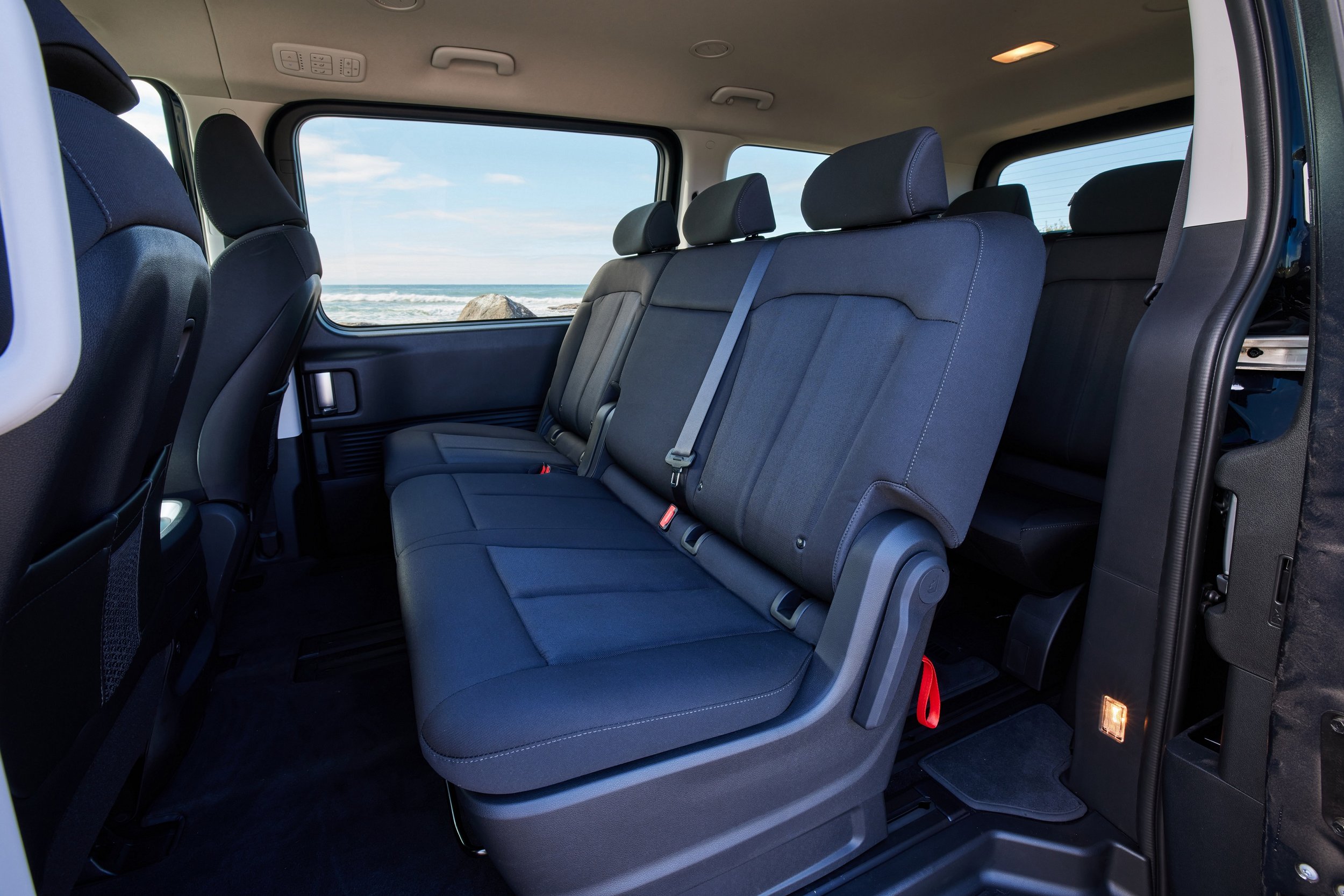


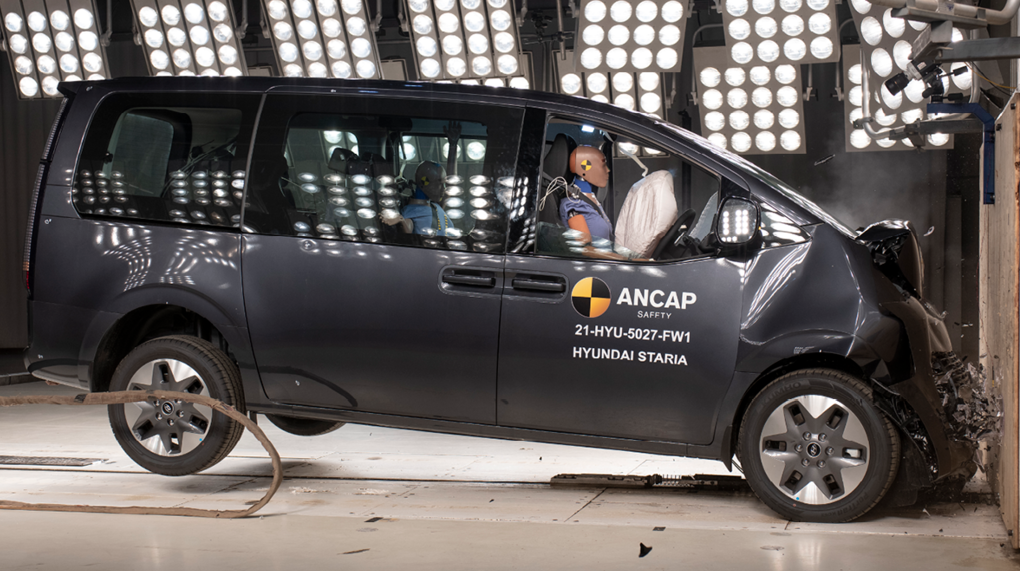




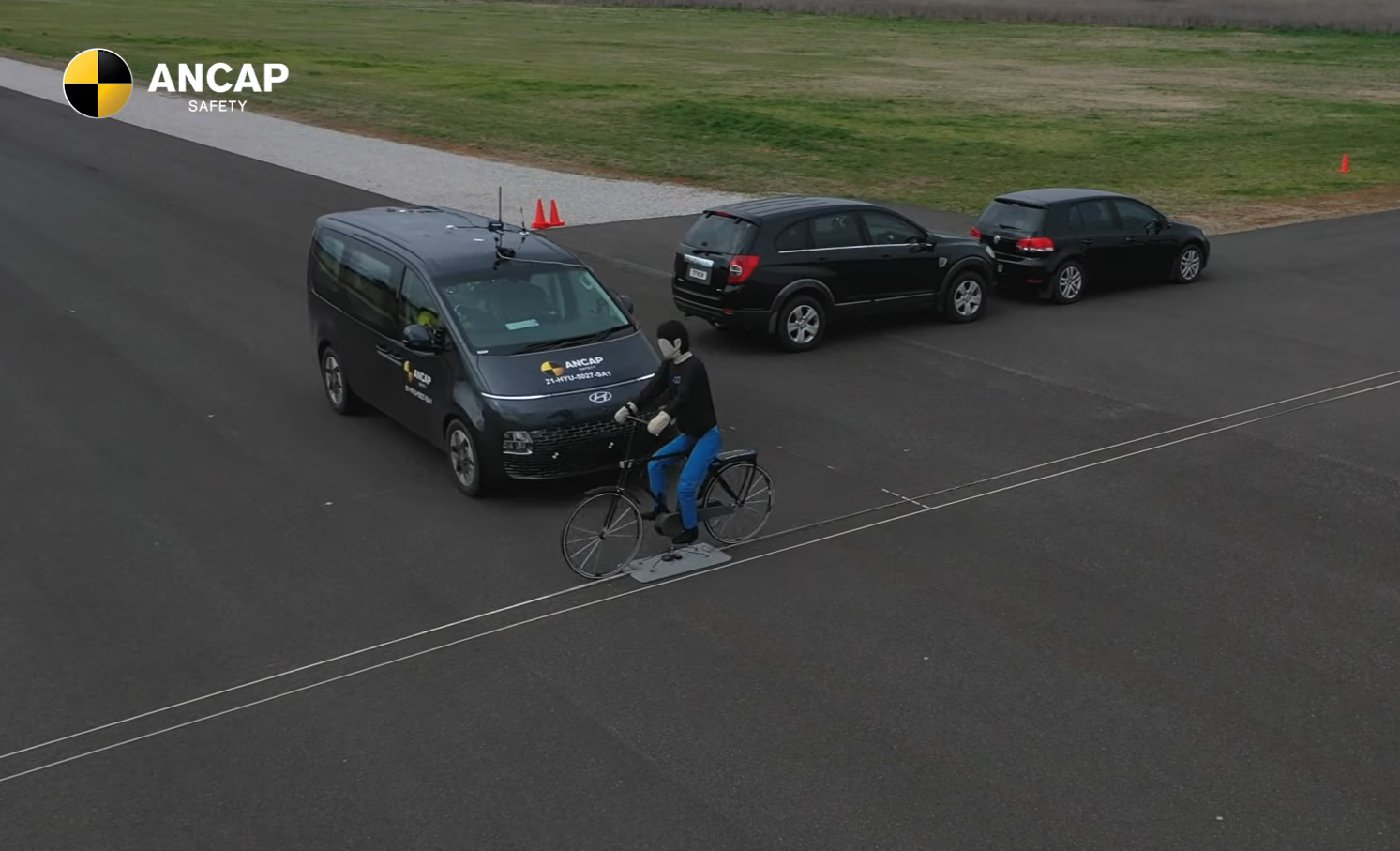
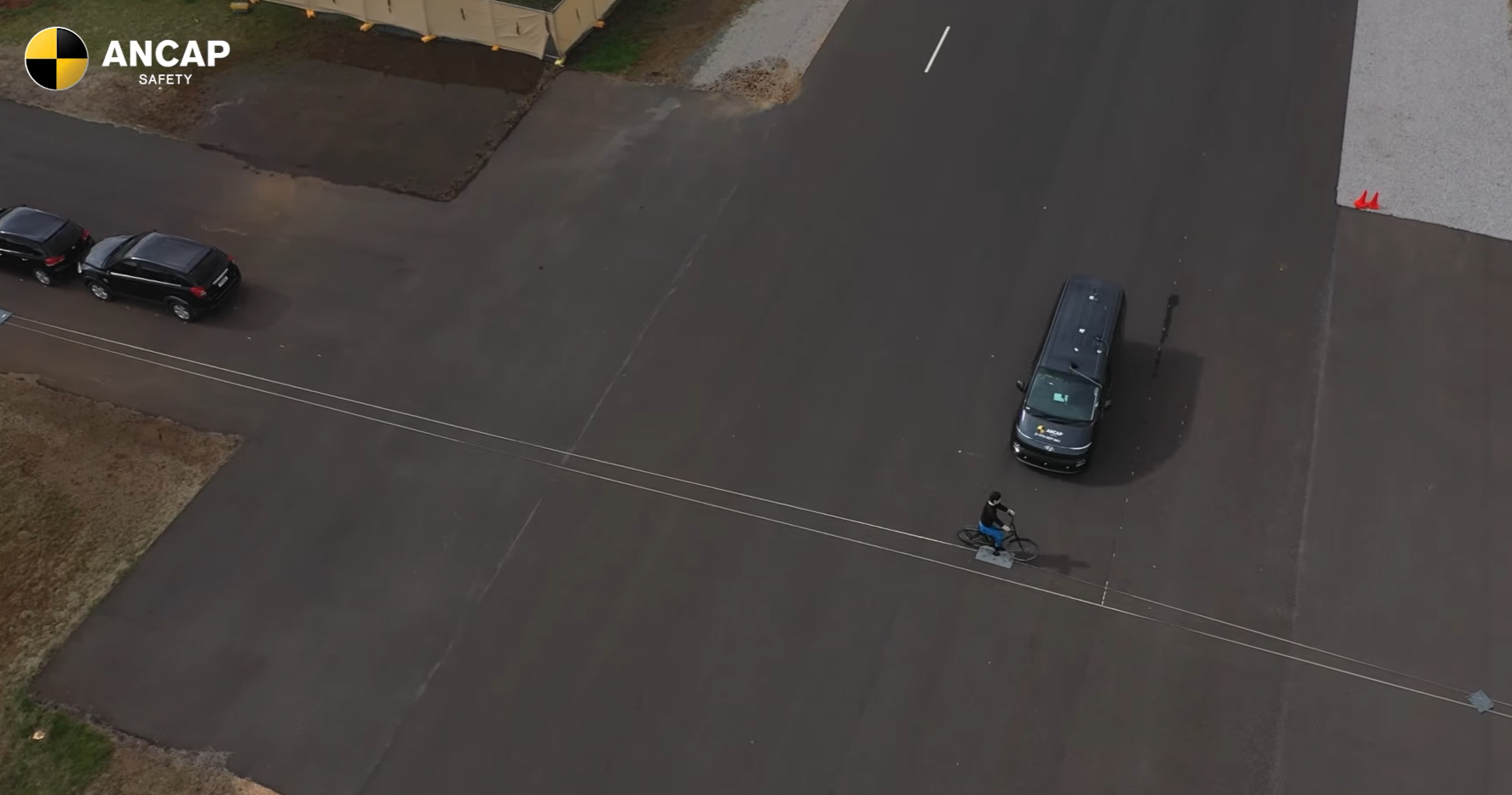




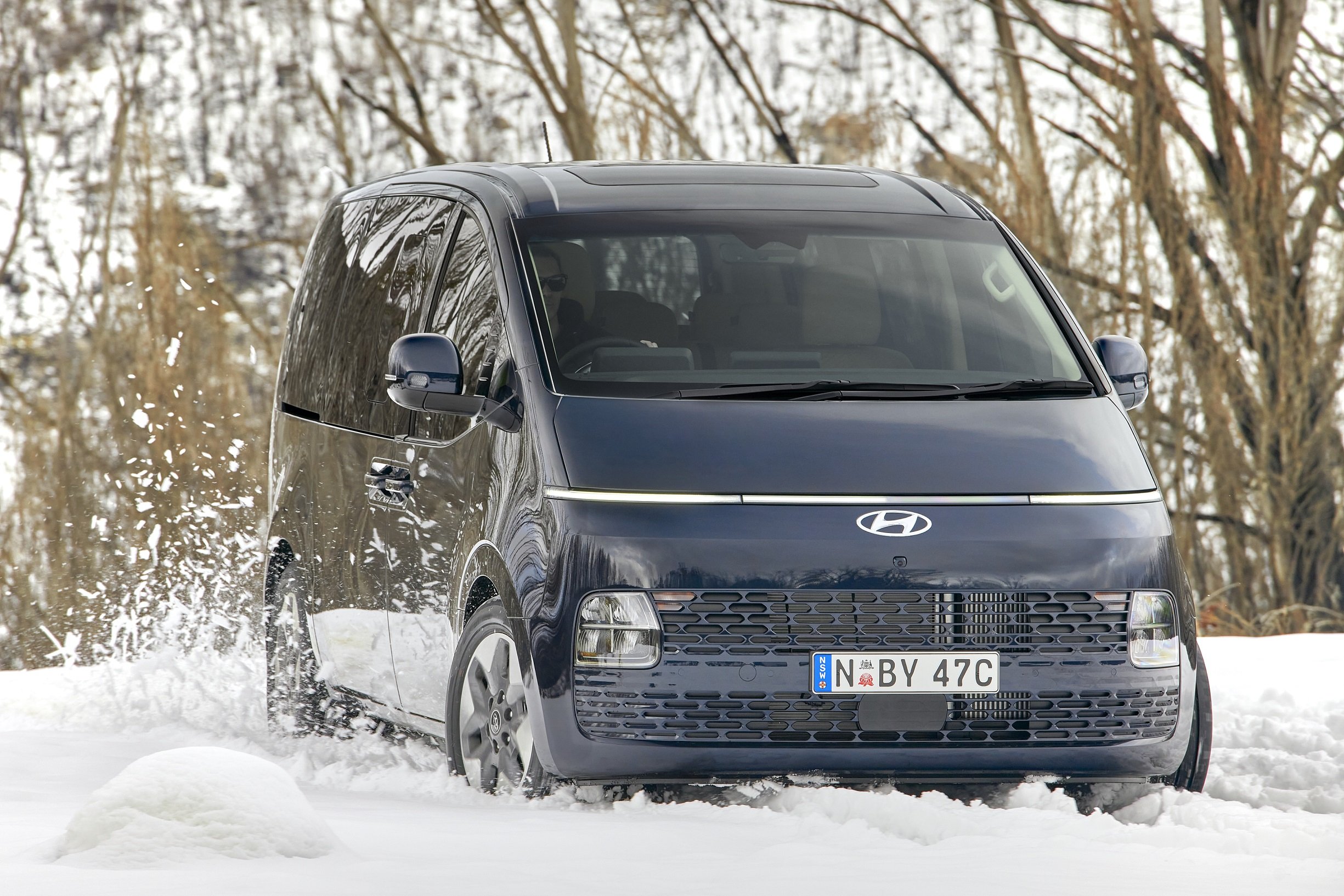
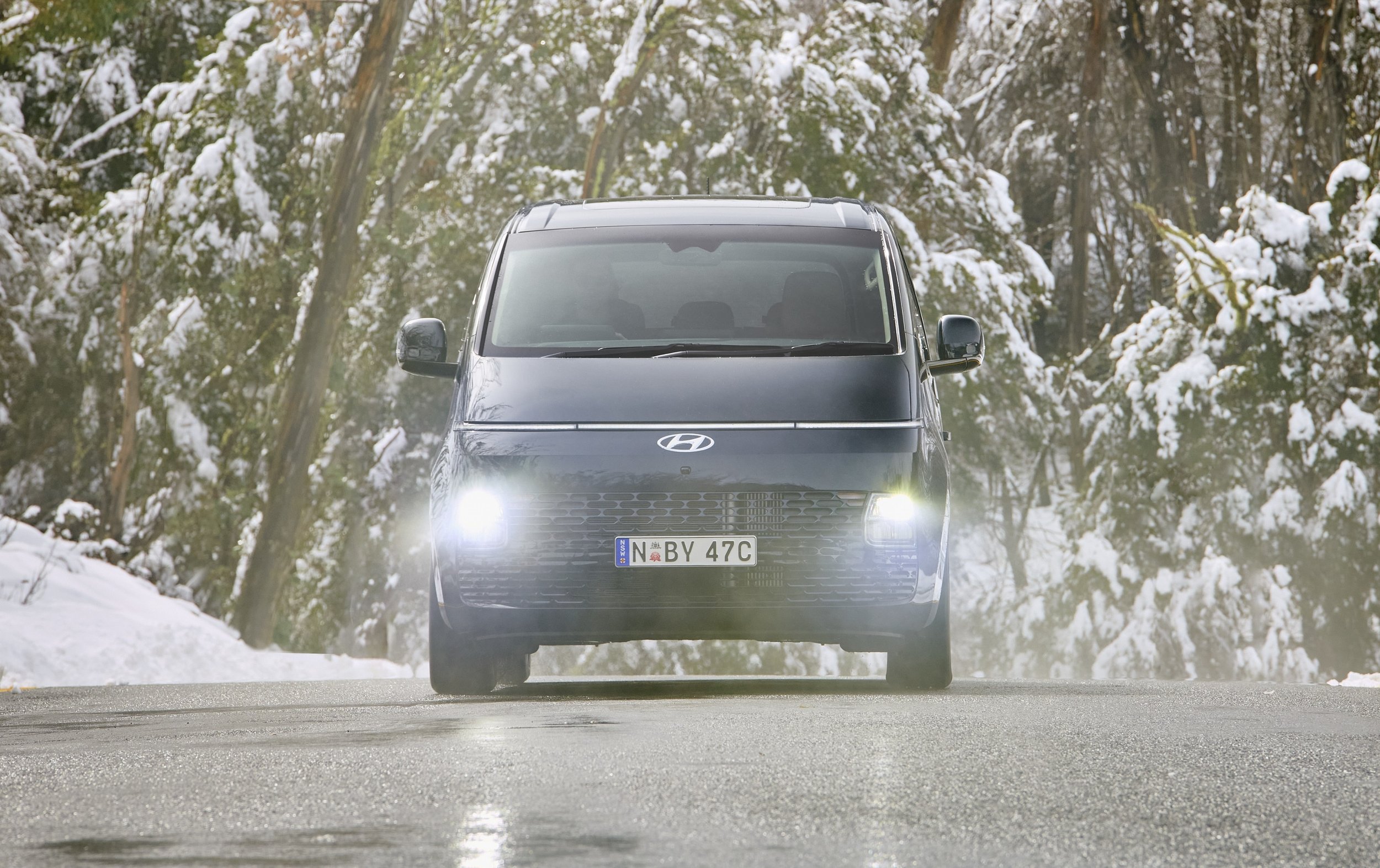

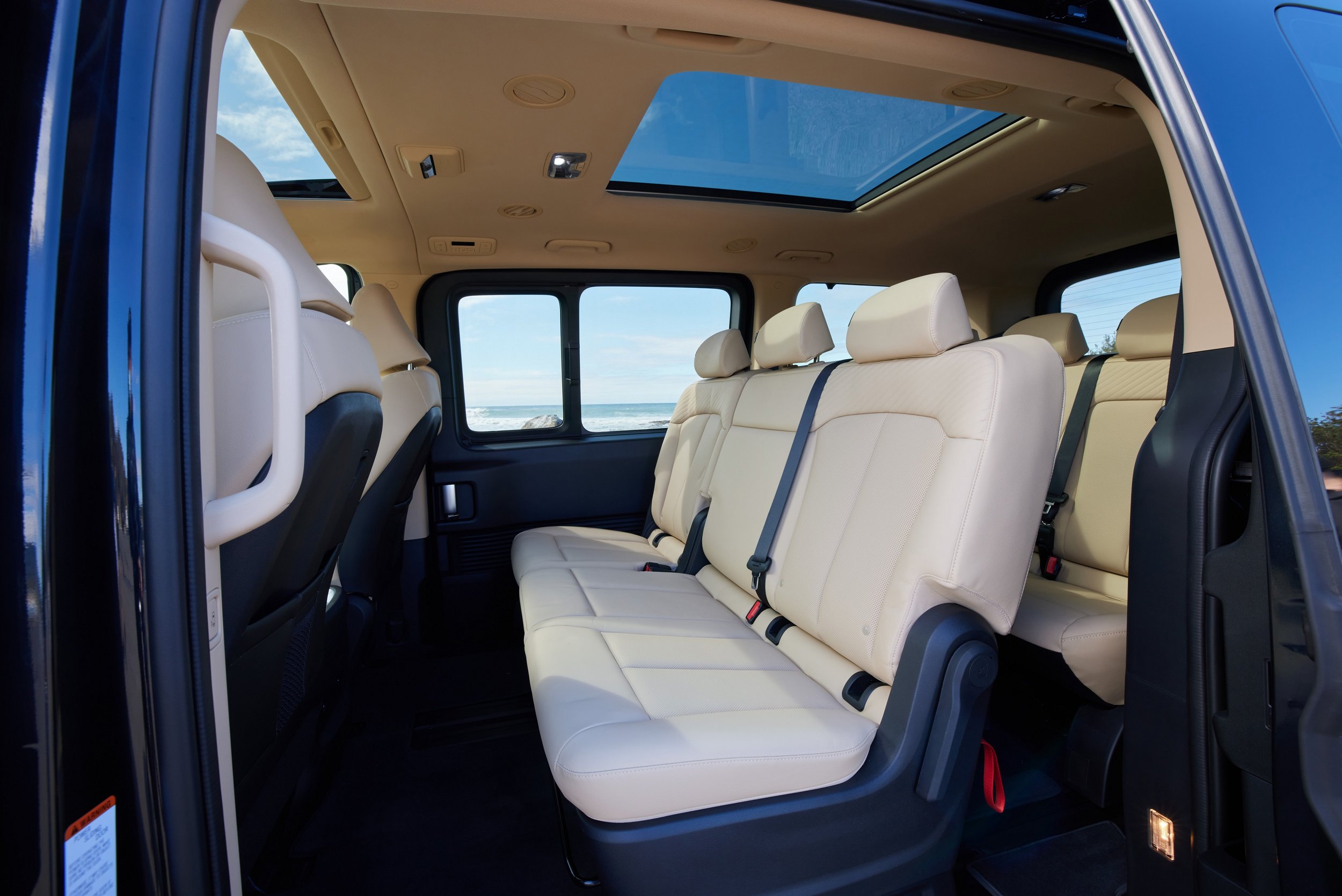



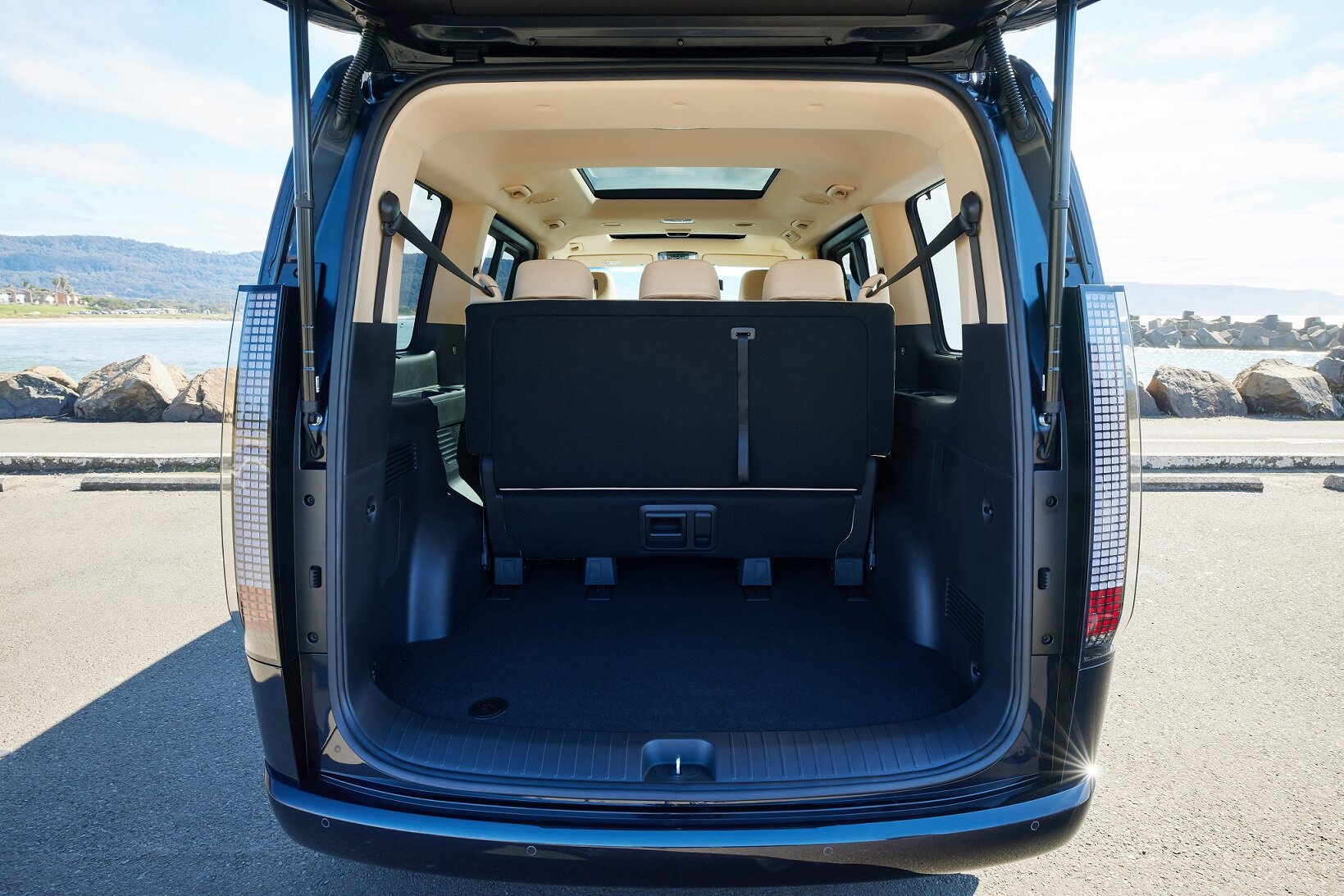

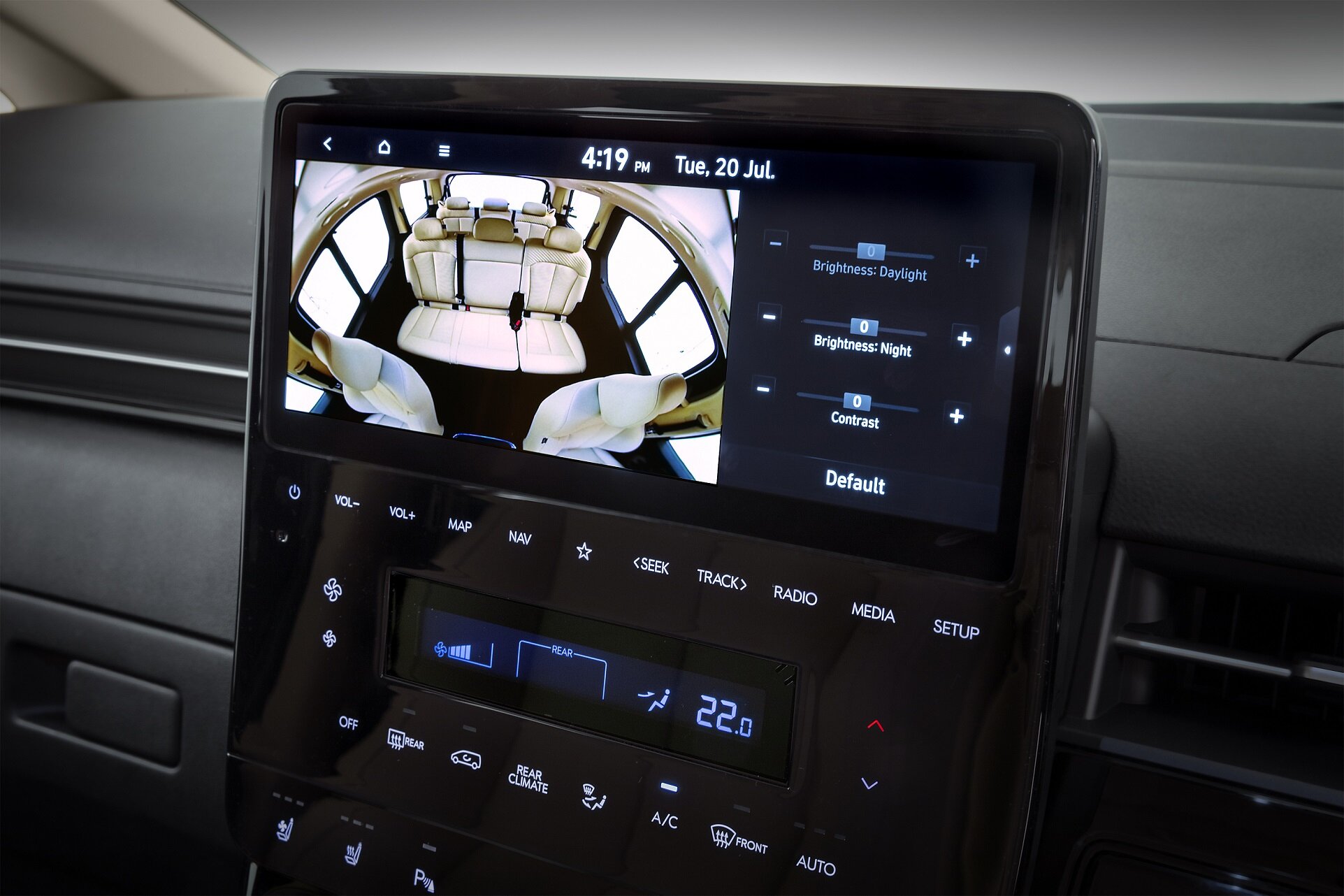
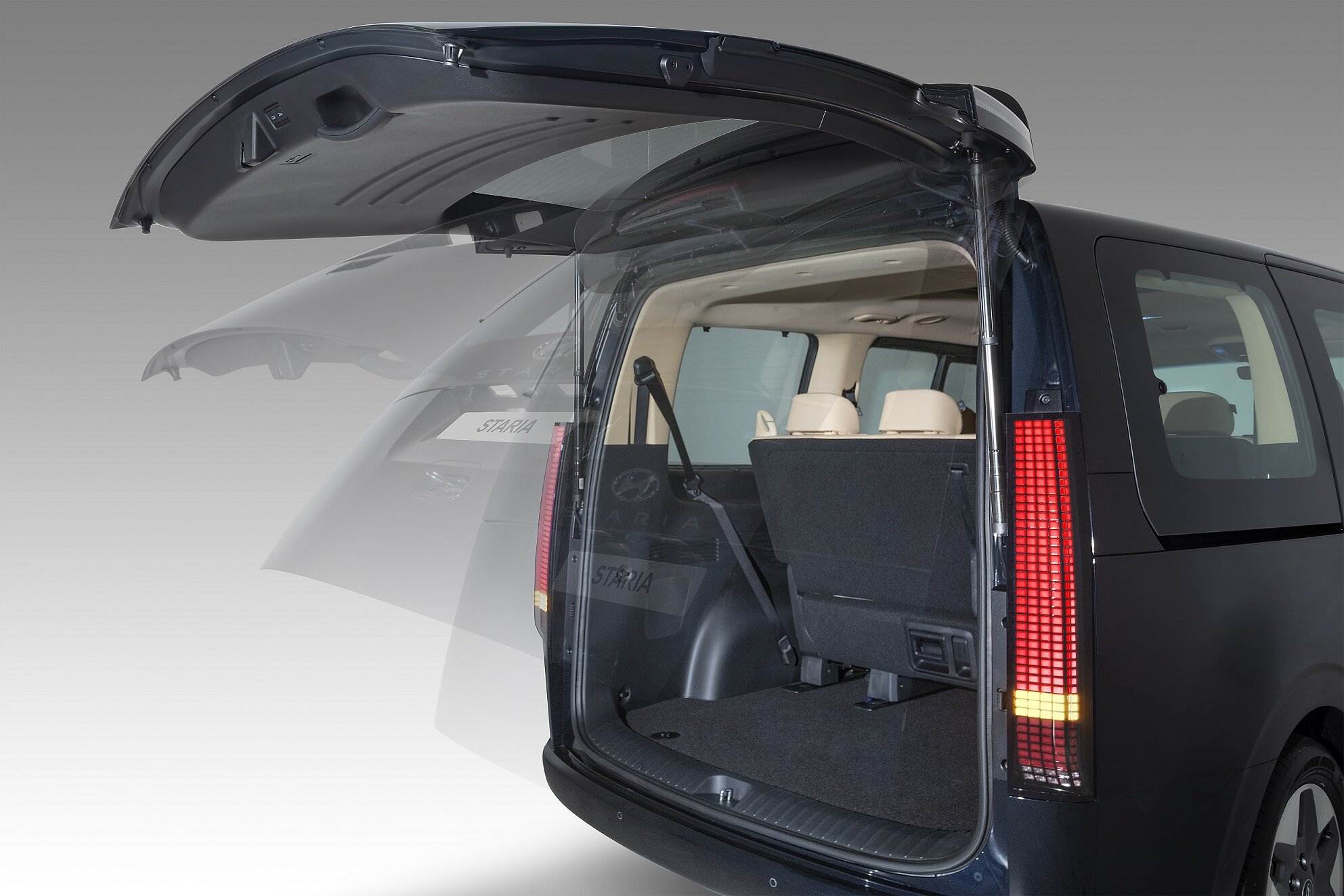
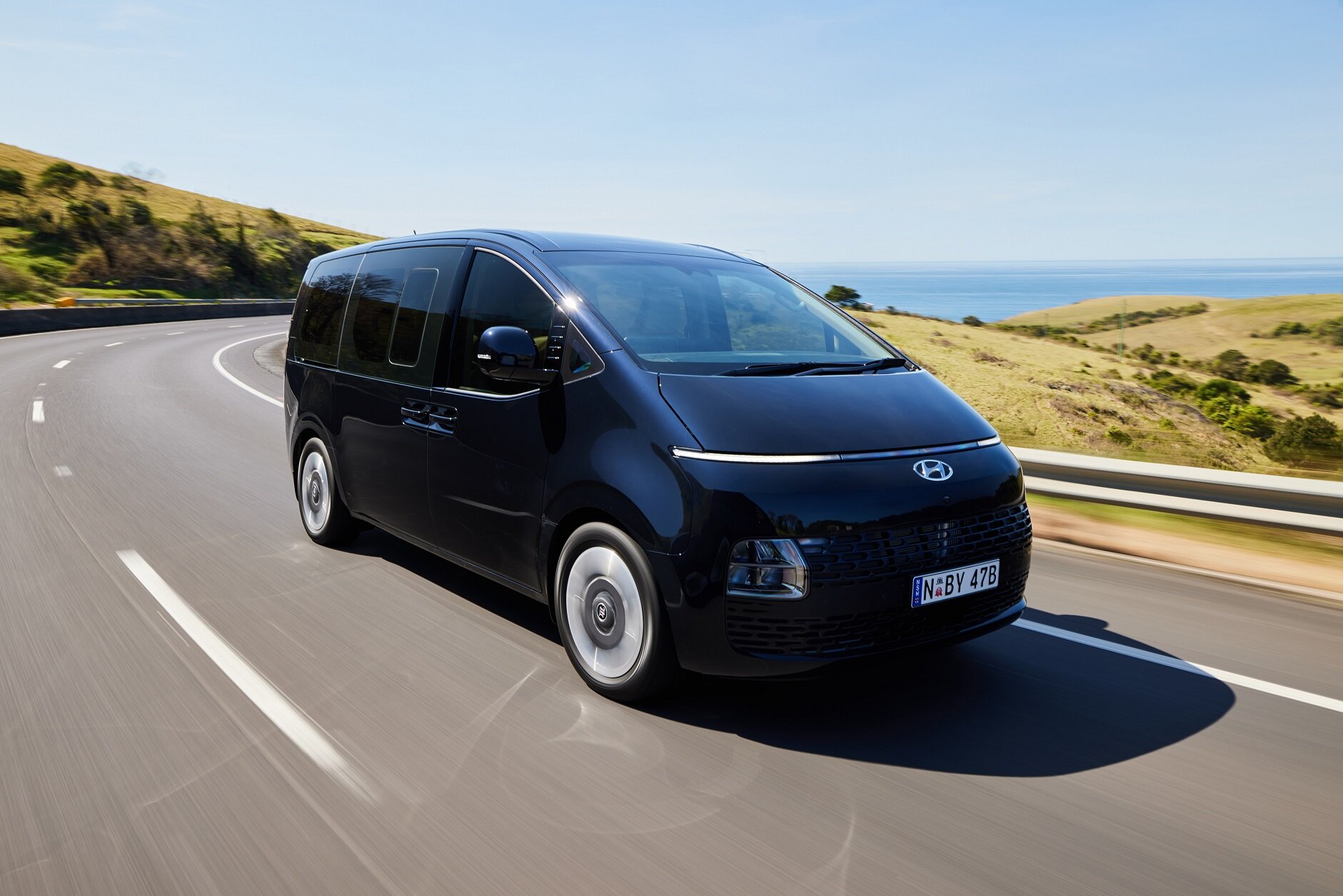
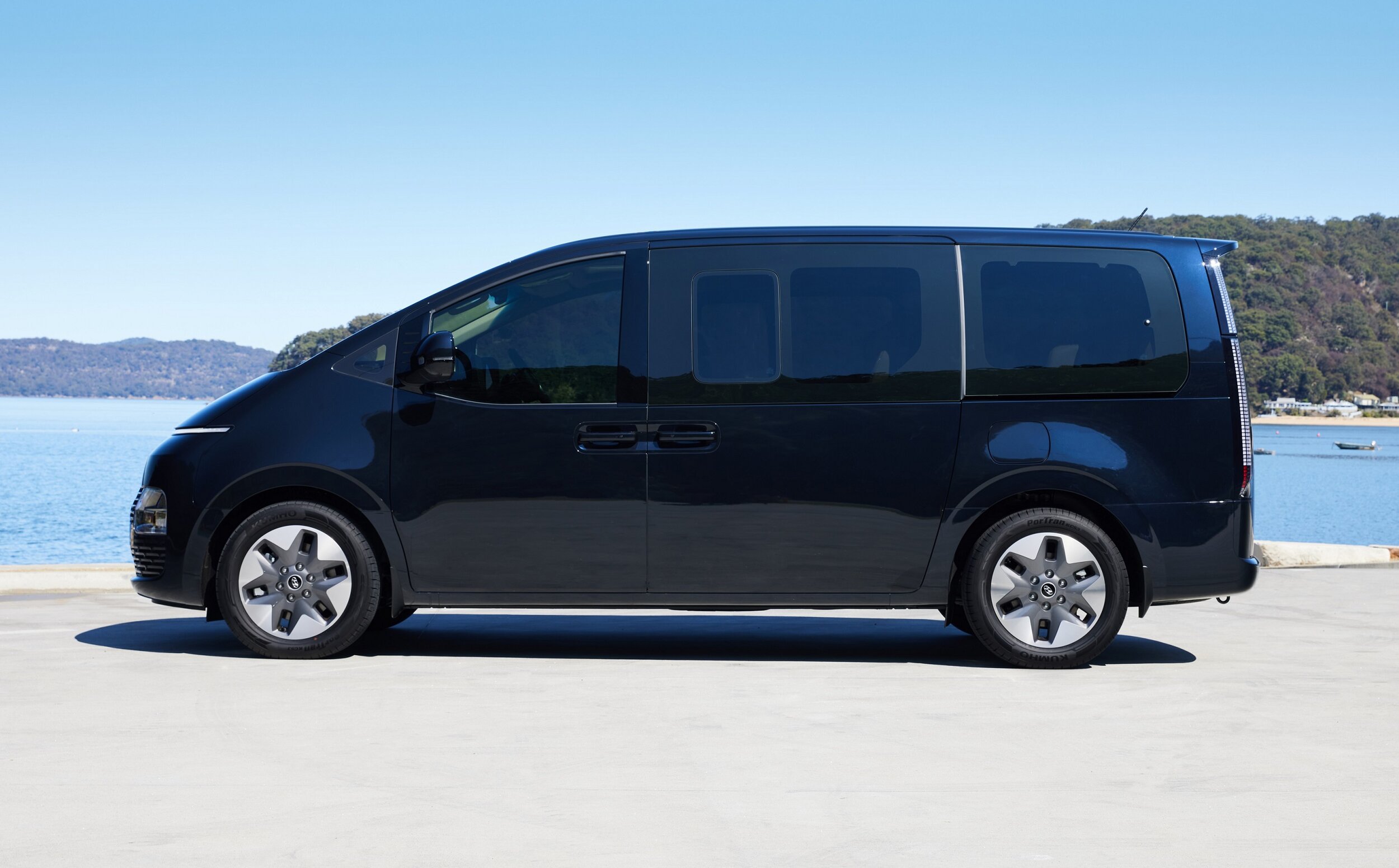


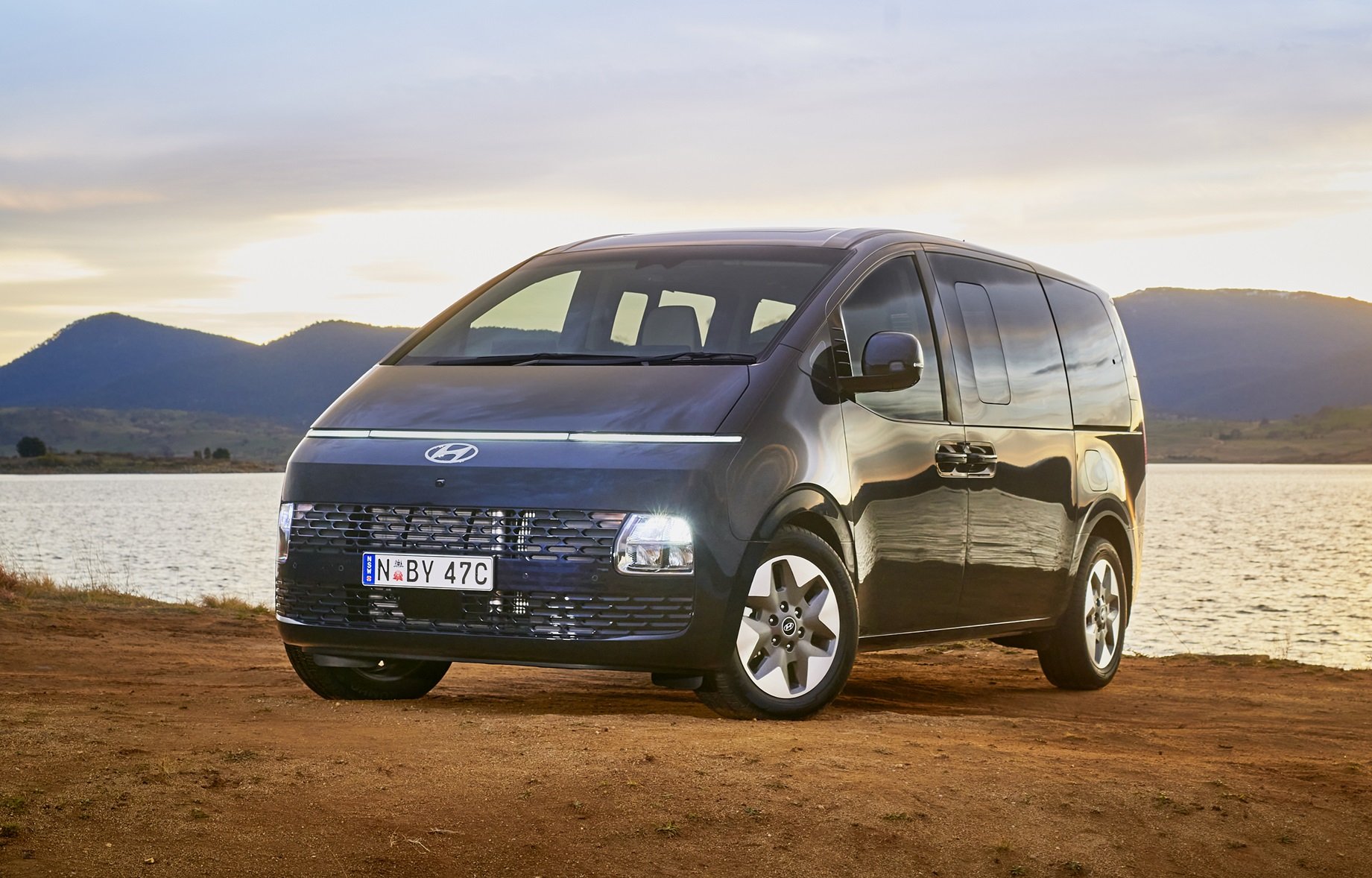










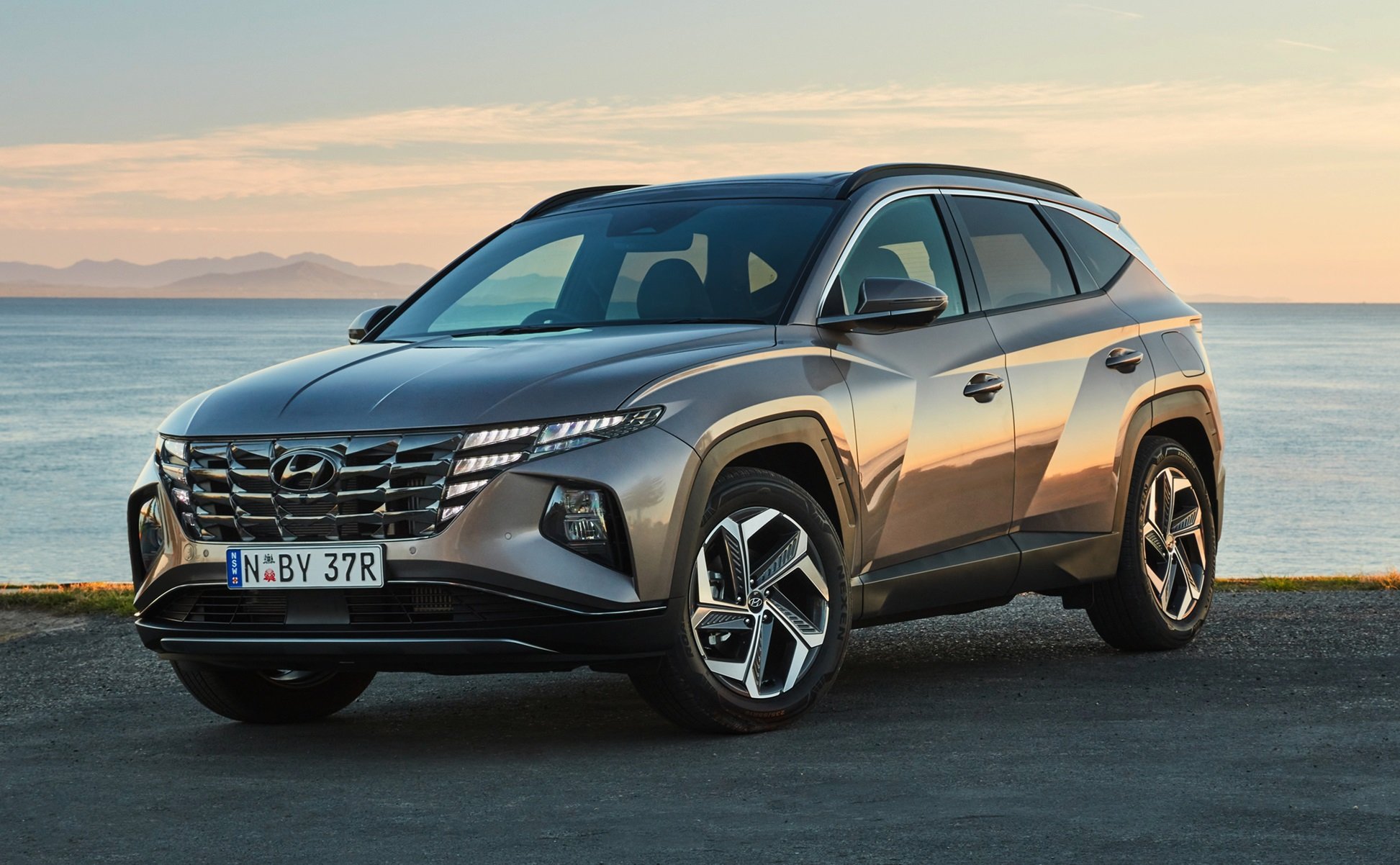

Toyota RAV4 is the best-selling medium SUV in Australia, offering good resale value and envious fuel economy. If you need an enormous boot and a simple, functional family vehicle, RAV4 is hard to beat.